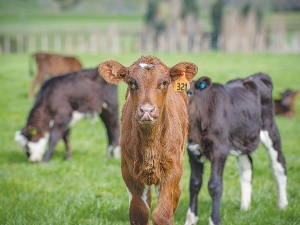TB slaughter levy for dairy jumps 75c/head
TB differential slaughter levy rates are changing with dairy animals paying $12.25/head, an increase of 75c from next month.
 Dairy farmers producing high quality calves often felt frustrated with variable and inconsistent demand from beef finishers.
Dairy farmers producing high quality calves often felt frustrated with variable and inconsistent demand from beef finishers.
Dairy farmers are being encouraged to consider using genetically superior beef bulls across their herds this spring to help create greater value along the value chain.
This is based on a recent report summarising the findings of the Beef + Lamb New Zealand Genetics’ Dairy Beef Progeny Test (DBPT).
Written by farm consultant Bob Thomson, the report summarises the findings of a whole-farm modelling process, where the progeny of the highest ranked beef bulls from the DBPT were compared with the progeny of average bulls.
These showed a 15 per cent growth advantage at 400 and 600-days compared to the average bulls. This would improve gross margin returns by between $211 and $261/ ha and improve feed conversion efficiency by 9 per cent. This in turn would reduce greenhouse gas emissions.
The modelling demonstrated that when the top 10-15 per cent of DBPT bulls for marbling (intramuscular fat) were compared with the average DBPT bulls there was a 27 per cent improvement. This correlated with an increase in the strike rate with beef quality supply programmes, although with a price premium of 30c/kg CW, this increased the gross margin by up to another $51/ha.
The modelling also compared one and two winter finishing policies and highlighted clear advantages and disadvantages to both. The ranking of DBPT bulls did not change between the two policies.
Compared to the twowinter, the one-winter system occupied one third less land area with 15 per cent more feed conversion efficiencies.
The disadvantage was in lighter carcase weights (160-220kg CW) when processed between November and February. These weights were outside targeted beef grading and associated payment schedules.
Building a connection between dairy farmer and finisher
The report noted a disconnect between dairy farmers and beef finishers and the advantages for both parties to address this.
Working with a dairy farmer who is investing in superior beef genetics gives the finisher the opportunity to benefit from significantly improved growth rates and carcase attributes.
The report states that this disconnect has come about because finishers tend to prefer to buy dairy-beef spring-born weaners in autumn rather than rear them over summer. In drought years, when this is most apparent, there is little difference in the price between autumn and spring calves.
Dairy farmers producing high quality calves often felt frustrated with variable and inconsistent demand from beef finishers irrespective of whether they are four to five-day old weaners or 100kg weaners.
“Once the calves leave the dairy farm the connection back to their genetic merit is usually lost.
The National Wild Goat Hunting Competition has removed 33,418 wild goats over the past three years.
New Zealand needs a new healthcare model to address rising rates of obesity in rural communities, with the current system leaving many patients unable to access effective treatment or long-term support, warn GPs.
Southland farmers are being urged to put safety first, following a spike in tip offs about risky handling of wind-damaged trees
Third-generation Ashburton dairy farmers TJ and Mark Stewart are no strangers to adapting and evolving.
When American retail giant Cosco came to audit Open Country Dairy’s new butter plant at the Waharoa site and give the green light to supply their American stores, they allowed themselves a week for the exercise.
Fonterra chair Peter McBride says the divestment of Mainland Group is their last significant asset sale and signals the end of structural changes.